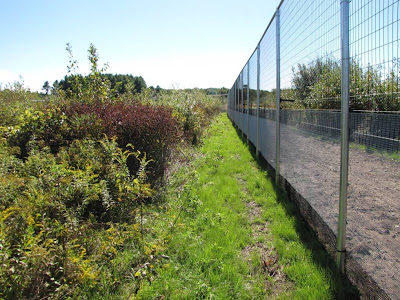DID YOU KNOW? |
| The New England cottontail has become so rare that it's a candidate for protection under the Endangered Species Act. What's a candidate? (PDF) |
Well, not necessarily. You may have seen rabbits in New England, but probably not the rare New England cottontail.
While these rabbits may closely resemble the more commonly seen eastern cottontail, they require a much more specific type of home and are known as habitat specialists. New England cottontails need dense thickets, and they hesitate to stray from cover.
As that habitat has been lost to development and maturing forest, the New England cottontail population has dramatically declined. These issues, along with habitat separated or fragmented by expanding roads and highways, make it difficult for these rabbits to find food or mates.
 |
| A New England cottontail released after being raised in captivity. Credit: USFWS |
It may sound ironic, but these rabbits do need our help to breed. So who plays matchmaker for these threatened rabbits? We do!
The U.S. Fish and Wildlife Service, the University of New Hampshire, the University of Rhode Island, all the New England states and the Roger Williams Park Zoo are working to bring the rabbits together to breed and grow in captivity. The pilot captive breeding program was initiated in 2011, and successful litters have come from the program at the Rhode Island zoo.
The first group overwintered in a hardening pen located at Ninigret National Wildlife Refuge in Rhode Island, and the most recent group found its way to the newly constructed pen at Great Bay National Wildlife Refuge in New Hampshire.
These one-acre pens are fenced in areas of shrub and thicket habitat, where the rabbits can adapt from their living at the zoo to living in the wild. Predator proof and under close watch by staff, these pens make it easier for the rabbits than if they were just released to fend for themselves.
 |
| The hardening pen at Great Bay National Wildlife Refuge in Massachusetts. Credit: USFWS |
Just last month, on September 19, lots of excitement swirled around the next group of rabbits to leave the Roger Williams Park Zoo. Heidi Holman, wildlife biologist with New Hampshire Fish and Game, loaded up nine rabbits for their ride to the Great Bay Refuge.
A morning of rain and cold weather had everyone on edge that the transition into the newly created pen would be difficult on the rabbits. But by the time Heidi and the rabbits arrived, the sun was shining and perfect for such a momentous occasion.
Refuge manager Graham Taylor, several of his staff members and staff from nearby Rachel Carson National Wildlife Refuge in Maine were on hand to witness the release. Seven pairs of eyes watched anxiously as one by one, each rabbit was taken out of the carriers and placed into their temporary home.
They sat a moment, sniffed their new surroundings, and then dashed away into the shrubs.
 |
| Heidi Holman releases one of the rabbits! Credit: USFWS |
The other group of rabbits at Ninigret Refuge were released in the spring to an offshore island with plenty of thick habitat and minimal predators, where they continue to do well.
The Great Bay Refuge rabbits will stay in the pen throughout the winter and will be released to sites in New Hampshire to supplement wild populations next spring. During their stay, we will monitor the rabbits and assess their health, and if needed, we will provide extra food to give them that extra boost.
We hope that one day, the New England cottontail can again be the dominant rabbit of its namesake.
More:
No comments:
Post a Comment